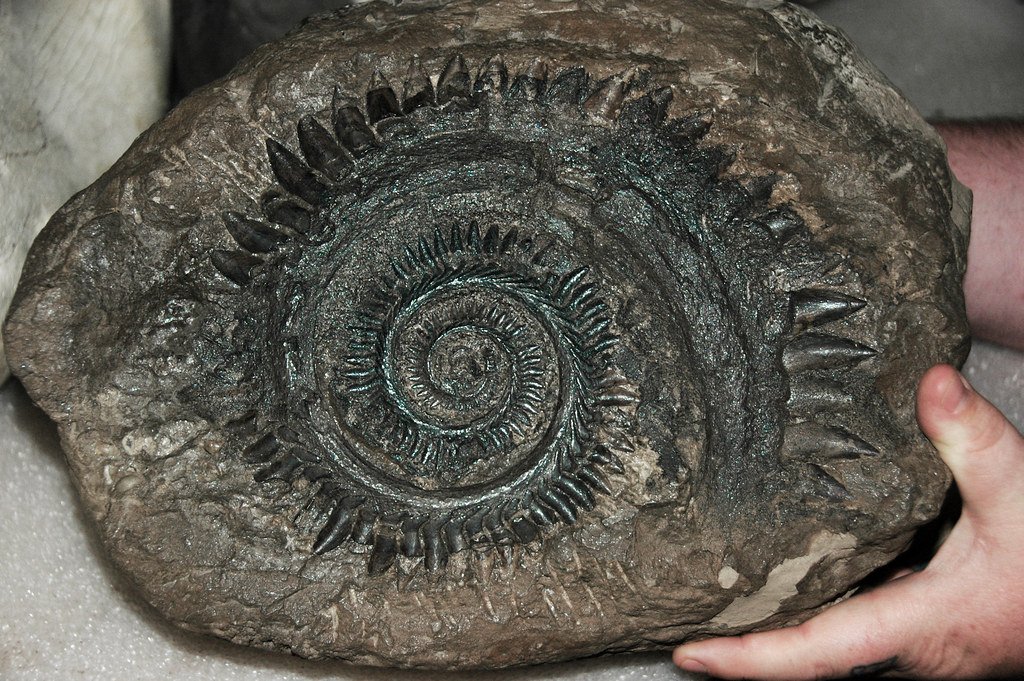Imagine the ancient seas filled with monstrous creatures whose appearances could both amaze and terrify. Among these oceanic giants swam Helicoprion, a unique prehistoric fish that has puzzled scientists for over a century. What sets Helicoprion apart from its contemporaries is a peculiar spiral of teeth, creating an enigma that has intrigued paleontologists since its discovery. Tasked with assembling an accurate image of this ancient predator, researchers have pieced together its extraordinary story, unveiling fascinating insights about life in the deep past.
Helicoprion’s Discovery

The first fossils of Helicoprion were discovered in the late 19th century in the Ural Mountains of Russia. These initial finds were mysterious and confusing, consisting solely of a whorl of teeth that resembled a spiraled saw blade. Early attempts to reconstruct the creature led to imaginative and incorrect interpretations, with some scientists even suggesting that the teeth belonged to a marine gastropod.
Understanding the Tooth Whorl

The key to understanding Helicoprion lies in its distinctive spiral tooth arrangement, known as a “tooth whorl.” Unlike any other known marine creature, Helicoprion’s jaws housed these tightly curled teeth, which were replaced continuously throughout its lifetime. These unusual dental structures led to significant debate and investigation about their function and placement in the animal’s overall anatomy.
Reconstruction and Modern Insights

Recent advancements in technology, such as CT scanning, have shed light on the true nature of Helicoprion’s tooth whorl. Researchers discovered that the spiral was housed in the lower jaw, with the teeth functioning much like a conveyor belt, ideal for grasping and slicing through soft-bodied prey. This revelation corrected earlier theories that posited the whorl might have been located on the snout or even the dorsal fin.
Species and Habitat
Helicoprion was a member of the Eugeneodontida, an extinct order of cartilaginous fish related to present-day sharks and rays. These ancient predators thrived during the early Permian period, approximately 290 million years ago. Their fossils have been discovered worldwide, indicating they inhabited a variety of marine environments, likely thriving in warm, shallow seas.
Anatomical Comparisons with Modern Sharks

While superficially similar to modern sharks, Helicoprion possessed several distinct features beyond its tooth whorl. Like its contemporaries, this ancient fish lacked true bony structures, relying on cartilage for skeletal support. Additionally, its body shape was likely more elongated and adapted for rapid pursuit of prey rather than the broad, muscular builds seen in many of today’s shark species.
Diet and Feeding Habits

The unique dentition of Helicoprion suggests it primarily fed on soft-bodied animals, such as squid and small fish. The spiral of teeth allowed it to efficiently grasp and slice through its prey, making it a highly effective predator. This feeding strategy likely positioned Helicoprion as an apex predator in its ecosystem.
Challenges in Identifying Helicoprion’s Relatives

Connecting Helicoprion to modern-day species has posed substantial challenges. The absence of other skeletal fossils has hampered efforts to draw direct evolutionary lines. However, its close relation to another extinct group, the Holocephalians — which modern chimeras belong to — provides some clues about its position in the marine vertebrate lineage.
The Role of Technology in Paleontological Discoveries

Advancements in technology have been crucial in piecing together Helicoprion’s puzzle. CT scanning, digital modeling, and other non-invasive techniques have allowed scientists to virtually reconstruct the creature without damaging its delicate fossils. These tools have facilitated a better understanding of Helicoprion’s life and behavior, changing previous and often flawed interpretations.
Significance of Helicoprion in Paleontology

Helicoprion’s discovery and subsequent study highlight the intricate complexity of evolution and adaptation. This prehistoric fish serves as a reminder of the diversity of life forms that have existed on Earth, shaping our understanding of marine ecosystems over millions of years. Its study continues to inspire curiosity and fascination in both researchers and the public alike.
Conclusion

Helicoprion represents not just a creature of wonder from the distant past, but also a testament to the resilience and resourcefulness of life on Earth. As scientists continue to unearth the secrets embedded in ancient fossils, each discovery brings us closer to understanding the rich tapestry of natural history. The spiral of teeth in a Helicoprion’s jaws serves as a permanent reminder of the incredible diversity and adaptability of life across the ages. By studying these bygone giants, we earn a deeper appreciation for the complexity of life and the untold stories the fossil record holds.




